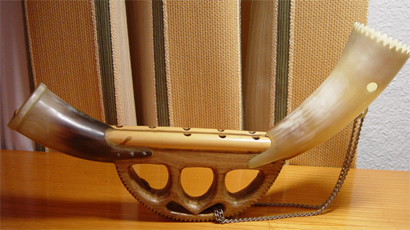Hornpipe (instrument) on:
[Wikipedia]
[Google]
[Amazon]


 The hornpipe can refer to a specific instrument or a class of
The hornpipe can refer to a specific instrument or a class of
Henry Balfour, "The Old British 'Pibcorn' or 'Hornpipe' and its Affinities"
'' Journal of the Royal Anthropological Institute'' (1891), pp. 142–154 (abstract on


 The hornpipe can refer to a specific instrument or a class of
The hornpipe can refer to a specific instrument or a class of woodwind instrument
Woodwind instruments are a family of musical instruments within the greater category of wind instruments.
Common examples include flute, clarinet, oboe, bassoon, and saxophone. There are two main types of woodwind instruments: flutes and ...
s consisting of a single reed, a large diameter melody pipe with finger holes and a bell traditionally made from animal horn. Additionally, a reed cap of animal horn may be placed around the reed to contain the breath and allow circular breathing for constant play, although in many cases the reed is placed directly in the mouth. It was also known as the pibcorn, pibgorn, or piccorn. One rare Scottish example, called the '' stock-and-horn'', is referred to by Robert Burns
Robert Burns (25 January 1759 – 21 July 1796), also known familiarly as Rabbie Burns, was a Scottish poet and lyricist. He is widely regarded as the List of national poets, national poet of Scotland and is celebrated worldwide. He is the be ...
among others. Other hornpipes include the Spanish '' gaita gastoreña'', the Basque '' alboka'' and the Eastern European '' zhaleika''. When joined with a bag, Baines refers to the instruments as "bag-hornpipes". and Baines, Anthony C. 1995 ''Bagpipes'', 3rd ed. Occasional Papers on Technology. Oxford: Pitt Rivers Museum.
Construction
The traditional hornpipe has one or two narrow internal bores between 4 mm and 12 mm each, with one or two idioglot single-reeds respectively, similar to the bagpipe drone reed, which is sometimes surrounded by a cap made of horn or wood which is sealed with the players lips. The melody pipe(s) can have between 5 ( pentatonic) and 8 finger holes (one of which may be a thumb hole) giving a first register range of up to an octave plus a note. The bell is shaped from a section of horn, wood or sometimes rolled bark, and may have tuning holes or decorative work. This class of instrument comprises the ancient predecessors to modern cylindrically bored reed instruments, such as the clarinet.See also
*Shawm
The shawm () is a Bore (wind instruments)#Conical bore, conical bore, double-reed woodwind instrument made in Europe from the 13th or possibly 12th century to the present day. It achieved its peak of popularity during the medieval and Renaissanc ...
References
External links
Henry Balfour, "The Old British 'Pibcorn' or 'Hornpipe' and its Affinities"
'' Journal of the Royal Anthropological Institute'' (1891), pp. 142–154 (abstract on
JSTOR
JSTOR ( ; short for ''Journal Storage'') is a digital library of academic journals, books, and primary sources founded in 1994. Originally containing digitized back issues of academic journals, it now encompasses books and other primary source ...
)
{{Authority control